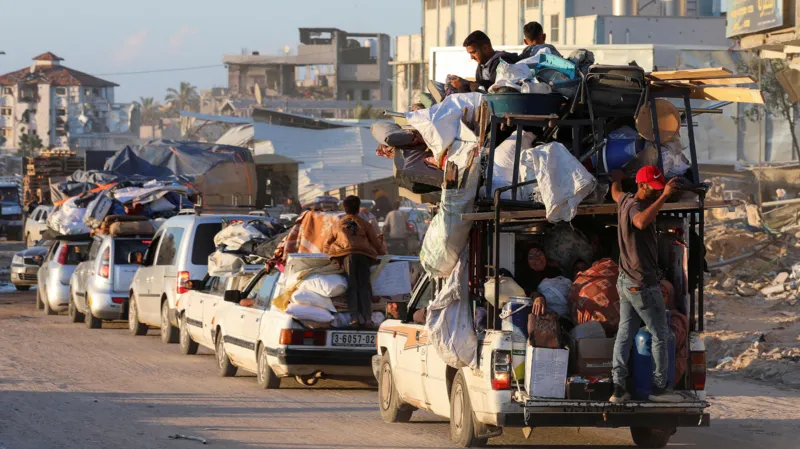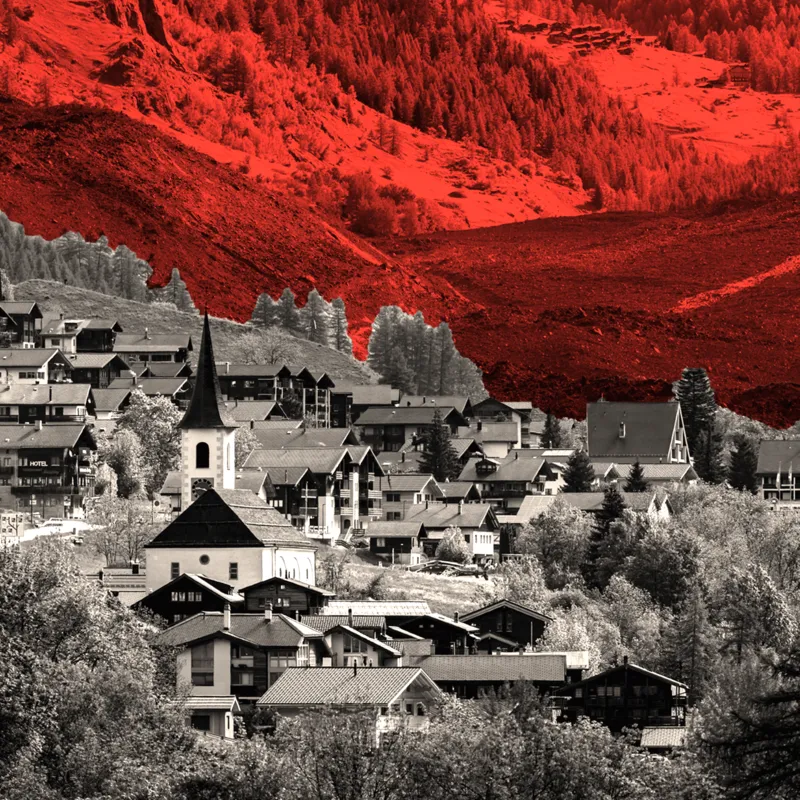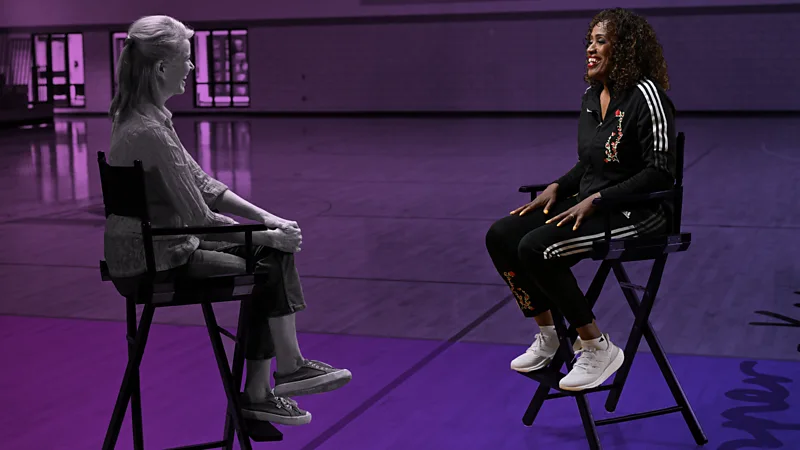Gaza war: Where has Israel told Rafah displaced to go?
Many Palestinians are fleeing eastern parts of Rafah, after the Israeli military ordered their evacuation before starting an operation in the southern Gaza city.

On Monday the military told the tens of thousands of people affected to begin heading towards an “expanded humanitarian area" to the north, where it said they would find field hospitals, tents and basic supplies.
But Palestinians warned that the area was made up of neighbourhoods that were already overcrowded and lacking in essential services, were still coming under intense bombardment, or had been left in ruins by recent fighting.
Reuters Tents constructed for displaced Palestinians in the al-Mawasi area, in the southern Gaza Strip (25 April 2024)Reuters
Several tented encampments have been set up north of Rafah in recent weeks
Almost seven months into its war against Hamas, senior Israeli government and military figures have insisted that victory is impossible without a full-scale ground assault on Rafah.
But Israel’s closest ally, the US, has said it has yet to see a credible plan to protect the more than a million displaced Palestinians sheltering there - half of them children.
In March, the Israel Defense Forces (IDF) said it was intending to evacuate most, if not all, of the civilians in Rafah ahead of major offensive and send them to “humanitarian islands” in central Gaza where aid and tents would be provided.
It appeared that plan was being at least partly put into action, when the IDF announced the evacuation of eastern Rafah and the “expansion of the humanitarian area” in nearby al-Mawasi as part of its preparations for ground operations there.
“This expanded humanitarian area includes field hospitals, tents and increased amounts of food, water, medication and additional supplies,” an IDF statement said.
An IDF spokesperson said the evacuation would be “gradual” and affect an estimated 100,000 residents and displaced people. However, a Palestinian Red Crescent official put the figure at 250,000 and a UN official said many others would be on the move because they feared this was only “the first phase in a longer operation”.
Flyers dropped by Israeli aircraft over Rafah on Monday featured a map that identifies nine area blocks in south-eastern Rafah, including al-Shokat, al-Salam, al-Jneineh, Tabbet Zarei and al-Yarmouk, as well as open land around the Israeli-controlled Kerem Shalom and Egyptian-controlled Rafah border crossings.
The UN said the evacuation zone covered more than 30 sq km (12 sq miles) and was home to nine sites sheltering displaced people, as well as three clinics and six warehouses.
The flyer instructed all residents to evacuate immediately and head towards an approximately 60 sq km area stretching north along the Mediterranean coast from al-Mawasi - a narrow strip of agricultural land that has long been an IDF-designated “humanitarian zone” - to the city of Khan Younis and the central town of Deir al-Balah.
The IDF did not provide any details about the locations of the tents for the people being evacuated, but in recent weeks satellite images have shown several encampments constructed north of Rafah and west of Khan Younis.
Map showing Israeli-declared evacuation zone in Rafah and expanded humanitarian area (6 May 2024)
Mohammed Daoud said the 35 members of his family living had “no choice but to leave” after finding out that their house in the Oraiba area was inside the evacuation zone.
“We do not know where to go and how we will manage,” he told the BBC.
Rasha Sheikh Khalil, a displaced woman living in a tent in Rafah with her husband and four children, said: “I had started preparing my bags and getting ready to return to my neighbourhood in Gaza City, but the bad news [on Monday] surprised us.”
“No-one cares about our fate. For seven months we have not tasted comfort and tranquillity.”
Ghada el-Kurd, a mother-of-two who has been displaced six times over the last four months, told the BBC that she was living only 15 minutes away from one of the evacuated areas but was staying put for now.
“I’m so confused... I have no place to go. This was the last place I know,” she said.
“If I want to come back to Khan Younis there is no place - it is all destroyed. [As for] areas of al-Mawasi, they are crowded and I cannot any more live inside a tent - it’s so hot and my health does not allow me to be in such a situation. Regarding Deir al-Balah... there are a lot of air strikes there... and it is a very dangerous area.”
Researchers estimate that 50% of the buildings in Khan Younis are likely to be destroyed or damaged
The UN said it was “not taking part in involuntary evacuations or in the setting up of any displacement zones”.
But James Elder, a spokesman for the UN children’s agency, Unicef, who was in Gaza last month, said Ghada el-Kurd’s assessment of the IDF’s humanitarian area was “absolutely spot on”.
"There's nowhere to go. Khan Younis, let's be clear, is rubble,” he told the BBC. “I've walked around those streets of Khan Younis. It's not a little bit destroyed, it's utterly devastated.”
“Deir al-Balah... has now got raw sewage running through the streets because sanitation has just been devastated, and al-Mawasi is a beach, a sandy area, and we're starting to hit summer.”
“We've already had reports of children dying of dehydration. So when we're told that people should move to humanitarian zones, that's a terrifying irony when humanitarians aren't working in these zones."
But, he added: “Of course, families will move. They will move because they will move or be bombed.”
Mr Elder said the aid operation in Gaza was already very fragile because it was “continually undermined by bombings, by insecurity, by denial of access”, but that an Israeli offensive in Rafah could push it to breaking point.
UN officials are particularly concerned that the Rafah and Kerem Shalom crossings - the key entry points for aid into Gaza - could be closed during the current Israeli operation in eastern Gaza.
Kerem Shalom was shut on Sunday after four Israeli soldiers there were killed by 10 rockets launched by Hamas fighters from an area near the Rafah crossing, according to the IDF. But Israel’s prime minister told the US president on Monday that he would ensure Kerem Shalom reopened for humanitarian assistance.
Kerem Shalom was still closed on Tuesday morning, when the IDF announced that its troops had "obtained operational control" of the Gazan side of the Rafah crossing.
The UN agency for Palestinian refugees, Unrwa - which runs the largest humanitarian operation in Gaza - has said it will maintain a presence in Rafah as long as possible and would continue providing lifesaving aid.
But it has also warned that the continued interruption of the entry of aid and fuel supplies at the Rafah crossing would "halt the critical humanitarian response" across Gaza.
"The catastrophic hunger faced by people especially in northern Gaza will get much worse if these supply routes are interrupted," the agency said in a post on X, formerly Twitter, on Tuesday.
The IDF has said it is committed to facilitating humanitarian aid into and within Gaza and that it has established alternative crossings, including two in the north.
-bbc







